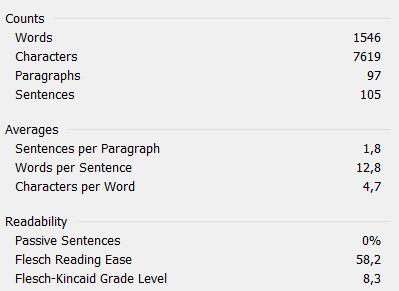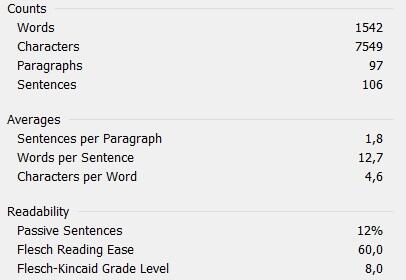Readability is an important characteristic of one’s writing signifying how easy or difficult it is for others to understand the written document. The higher the readability score, the easier it is to percept the ideas reflected in the text. In case the readability score is too low, the reader will have to focus not on the essence of writing but on discerning sentence structure and complicated words. Thus, the measure in question involves one’s way of presenting a written text in a way that would be clear for others to interpret.
For the present assignment, a brochure “Pandemic flu” (n.d.) was selected. The brochure offers information on the origin of the disease, its symptoms, at-risk populations, and treatment approaches. Upon performing the document’s grammar and spelling check, it became possible to receive its readability statistics (Figure 1). The statistics represent the number of words and characters, paragraphs, and sentences in the document.
Also, the average numbers of sentences per paragraph, words per sentence, and characters per word are given. The third block of the box deals directly with readability. Namely, the percentage of passive sentences is shown, the Flesch Reading Ease test result is indicated, and the Flesch-Kincaid Grade Level is mentioned. The strengths of the document include a very good Flesch-Kincaid Grade Level indicator and a moderately good Flesch Reading Ease test indicator.

The maximum that a document can receive by Flesch Reading Ease test is 100 points. The higher this score, the better the understanding of a document by the reader is (“Test your,” n.d.). It is commonly recommended to have this test’s score between 60 and 70 (“Test your,” n.d.). Therefore, the brochure’s score is a bit too low, which may result in readers’ poor understanding of the text given in it. Flesch Reading Ease test has the following formula: 206.835 – (1.015 x ASL) – (84.6 x ASW) (“Test your,” n.d.).
In this formula, ASL means the average length of sentences (“Test your,” n.d.). ASW means the average number of syllables per word (“Test your,” n.d.). The possible reason why the ASL indicator is too high is that the brochure contains some lengthy sentences. Thus, it is necessary to rewrite the document so that the ASL would become lower.
The Flesch-Kincaid Grade Level test indicates the ability of schoolchildren to understand the written piece. A score of 8.0 would mean that a student of the eighth grade could understand the brochure. The formula for this score is (.39 x ASL) + (11.8 x ASW) – 15.59 (“Test your,” n.d.). The brochure’s score in the Flesch-Kincaid Grade Level test is 8.3. This result indicates that the document will most likely present no difficulties for the readers of school age.
Upon performing some changes to the original brochure, readability statistics changed (Figure 2). Although the Flesch-Kincaid Grade Level test lowered a little (from 8.3 to 8.0), it is still within the acceptable norm. Meanwhile, the Flesch Reading Ease test score became 60, which is the minimum acceptable rate. The major alteration that helped to improve the document’s readability was changing long words to synonyms containing fewer syllables. Also, some passive voice forms were changed into active voice. Generally, simplifying the forms of words and sentences allowed increasing the brochure’s readability and made it reach the set minimum for both the Flesch Reading Ease test and the Flesch-Kincaid Grade Level test.

References
Pandemic flu. (n.d.). Web.
Test your document’s readability. (n.d.). Web.